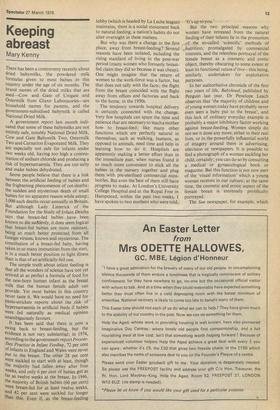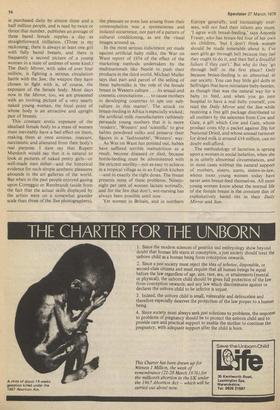Keeping abreast
Mary Kenny
There has been a controversy recently about dried babymilks, the powdered milk formulas given to most babies in this country under the age of six months. The brand names of the dried milks that are used—Cow and Gate of Unigate and Ostermilk from Glaxo Laboratories—are household names for parents, and the government-subsidised babymilk is called National Dried Milk.
A government report last month indicated that some of these babymilks are not entirely safe, notably National Dried Milk, Cow and Gate Babymilk Two, Ostermilk Two and Carnation Evaporated Milk. They are especially not safe for infants under two weeks old, having too high a concentration of sodium chloride and producing a risk of hypernatraemia. They are too salty and make babies dehydrated.
Some people believe that there is a link between the artificial feeding of babies and the frightening phenomenon of cot-deaths: the sudden and mysterious death of small babies for no apparent reason while asleep; 3,000 such deaths occur annually in Britain. But although Lady Limerick of the Foundation for the Study of Infant Deaths says that breast-fed babies have been known to die suddenly, it does seem logical that breast-fed babies are more resistant, being so much better protected from all foreign viruses, known and mysterious. The constitution of a breast-fed baby, having taken in so many immunities from the start, IS in a much better position to fight illness than is that of an artificially-fed one.
The simple truth about infant feeding is that all the wonders of science have not yet arrived at as perfect a formula of food for the new-born human infant as the breast milk that the human female adult can Provide. Yet most babies in this country never taste it. We would have no need for Panic-stricken reports about the risk of hYpernatraemia in artificial feeds if babies were fed naturally as medical opinion unambiguously favours.
It has been said that there is now a swing back to breast-feeding, but the evidence is not very substantial; in 1974, according to the government report Present Day Practice in Infant Feeding, 72 per cent of infants in England and Wales were never Put to the breast. The other 28 per cent were suckled to start with at least, though the majority had fallen away after four weeks, and only 6 per cent of babies got as far as twelve weeks at the breast. In 1946, the majority of British babies (60 per cent) were breast-fed for at least twelve weeks, and 42 per cent were suckled for longer than this. Even if, . as the breast-feeding
lobby (which is headed by La Leche league) maintains, there is a social movement back to natural feeding, a nation's habits do not alter overnight in these matters.
But why was there a change in the first place, away from breast-feeding? Several reasons have been isolated, including the rising standard of living in the post-war period (many women who formerly breastfed claim they did so because it was cheap). One might imagine that the return of women to the work-force was a factor, but that does not tally with the facts; the flight from the breast coincided with the flight away from offices and factories and back to the home, in the 1950s.
The tendency towards hospital delivery is certainly connected with the change. Very few hospitals can spare the time and patience that are necessary to teach a mother how to breast-feed; like many other functions which are perfectly natural in themselves, such as walking, humans, as opposed to animals, need time and help in learning how to do it. Hospitals are apparently making a better effort than in the immediate past, when nurses found it so much more convenient to stick all the babies in the nursery together and plug them with pre-sterilised commercial minibottles. But even the 'best of them still have progress to make. At London's University College Hospital and at the Ronal Free in Hampstead, within the past two weeks, I have spoken to two mothers who were told, 'It's up to you.'
But the two principal reasons why women have retreated from the natural feeding of their infants lie in the promotion of the so-called 'scientific' methods of nutrition, promulgated by commercial interests, and the relentless portrayal of the female breast as a cosmetic and erotic object, thereby obscuring to some extent at least its functional raison d'être—this being, similarly, undertaken for exploitative purposes.
In her authoritative chronicle of the first two years of life, Babyhood, published by Penguin last year, Dr Penelope Leach observes that 'the majority of children and of young women today have probably never even seen a baby put to the breast', and this lack of ordinary everyday example is probably a major inhibitory factor working against breast-feeding. Women simply do not see it done any more, either in their real lives, or in the powerfully influential world of imagery around them in advertising, television or newspapers. It is possible to find a photograph of a woman suckling her child, certainly ; you can do so by consulting a medical or gynaecological book or magazine. But this function is not now part of the 'visual information' which a young woman receives in our culture; at the same time, the cosmetic and erotic aspect of the female breast is extremely prolifically portrayed.
The Sun newspaper, for example, which is purchased daily by almost three and a half million people, and is read by twice or thrice that number, publishes an average of three bared female nipples a day as straightforward titillation. (Three is my reckoning; there is always at least one girl with fully bared breasts, and there is frequently a second picture of a young woman in a state of undress of some kind.) The Daily Mirror, with sales of over four million, is fighting a serious circulation battle with the Sun; the weapon they have chosen to fight with is, of course, the exposure of the female body. Most days now in the Mirror, too, we are presented with an inviting picture of a very nearly naked young woman, the focal point of whose body is an attractive and upright pair of breasts.
This constant erotic exposure of the idealised female body to a mass of women must inevitably have a bad effect on them, making them at once anxious, insecure, narcissistic and alienated from their body's real purpose. I dare say that Rupert Murdoch would say that it is natural to look at pictures of naked pretty girls—or well-made men either—and the historical evidence for such simple aesthetic pleasures abounds in the art galleries of the world. But when in the past people enjoyed gazing upon Correggio or Rembrandt (aside from the fact that the actual skills displayed by the artists were on a somewhat grander scale than those of the Sun photographers),
the pleasure or even lust arising from their contemplation was a spontaneous and isolated occurrence, not part of a pattern of cultural conditioning, as are the visual images around us.
In the most serious indictment yet made against artificial baby milks, the War on Want report of 1974 of the effect of the marketing methods undertaken by the multinationals like Nestle to push their products in the third world, Michael Muller says that part and parcel of the selling of these babymilks is 'the role of the female breast in Western culture . .. its sexual and cosmetic connotations ... to cause mothers in developing countries to ape our subculture in this matter'. The attack on breast-feeding in Africa is especially wicked; the artificial milk manufacturers ruthlessly persuade young mothers that it is more 'modern', 'Western' and 'scientific' to give babies powdered milks and preserve their figures in a 'fashionable', 'Western' way.
As War on Want has pointed out, babies have suffered terrible malnutrition as a result, become diseased or died, because bottle-feeding must be administered with the strictest sterility—not as easy to achieve in a tropical village as in an English kitchen —and in exactly the right doses. The breast presents none of these problems. Ninetyeight per cent of women lactate normally, and for the few that don't, wet-nursing has always been possible until now.
Yet women in Britain, and in northern
Europe generally, and increasingly overseas, will not feed their infants any more. 'I agree with breast-feeding,' says Antonia Fraser, who has breast-fed four of her own six children, 'but I don't think women should be made miserable about it. I've seen girls go through hell because they feel they ought to do it, and then feel a dreadful failure if they can't.' But why do they 'go through hell' in the first place? Only because breast-feeding is so abnormal in our society. You can buy little girl dolls in Selfridges that have miniature baby-bottles, as though that was the natural way for a baby to feed, and when you go into hospital to have a real baby yourself, you read the Daily Mirror and the Sun while receiving a free gift package distributed to all mothers by the salesmen from Cow and Gate, a gift which Cow and Gate, whose product costs 65p a packet against 20p for National Dried, and whose annual turnover for dried milk is around £14 million, can no doubt well afford.
The methodology of lactation is sprung upon a woman in social isolation, when she is in utterly abnormal circumstances, and in most cases without the natural support of mothers, sisters, aunts, sisters-in-law, whom most young women today have never seen breast-feed themselves. All most young women know about the normal life of the female breast is the constant diet of exploitatively bared tits in their Daily Mirror and Sun.



































 Previous page
Previous page